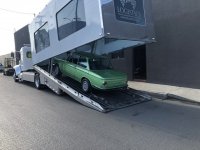Hello all,
I've been noodling on what to do next in preparation for bringing the Raven home to her new nest. This will involve taking the car in a trailer from the remote house in the woods to the new garage in town. The day of activities surrounding bringing the car home will be fun, amazing, and monumental (I may be overselling it, but plan to enjoy the journey regardless). But the logistics of this transport come into plan, and I thought what better than to solicit willing members herein for input. I may not be able to handle the advice, but will try to learn from it. Here are the particulars.
The car is "running", but not well. Driving it the two hour journey doesn't seem possible, though, given I've pulled the windscreens along with a number of other parts including the tail light assemblies. So, no driving it home.
PULL (the engine or head)?
Next would be to drive it onto the trailer. I probably need to tinker a bit even to do that, as I installed a 123 ignition but never finished dialing that in. Plus, I appear to have a healthy oil leak coming from the rear cam cover. I have a new gaskets and seal washers, etc - but access is tight back there. I'd planned on pulling the engine to get to this effectively. Alternatively, I could pull the head. This all sounds good, but seems like a lot of work to do just to roll the car into a trailer, and then back out on the other end. I suppose I can ignore the leak for these short bursts. But I'd still need to spend an unknown amount of time tuning, cleaning, and troubleshooting.
PUSH (the car)?
The last option - likely the simplest - is to push the dang thing onto the trailer, and push it back out on the other end. This is the least fun, but aside from a few moments of sweat and frustration, will be the least intensive I suspect. But I tend to find the simplest solutions least satisfying. That is a topic for another thread...
What say you?
I've been noodling on what to do next in preparation for bringing the Raven home to her new nest. This will involve taking the car in a trailer from the remote house in the woods to the new garage in town. The day of activities surrounding bringing the car home will be fun, amazing, and monumental (I may be overselling it, but plan to enjoy the journey regardless). But the logistics of this transport come into plan, and I thought what better than to solicit willing members herein for input. I may not be able to handle the advice, but will try to learn from it. Here are the particulars.
The car is "running", but not well. Driving it the two hour journey doesn't seem possible, though, given I've pulled the windscreens along with a number of other parts including the tail light assemblies. So, no driving it home.
PULL (the engine or head)?
Next would be to drive it onto the trailer. I probably need to tinker a bit even to do that, as I installed a 123 ignition but never finished dialing that in. Plus, I appear to have a healthy oil leak coming from the rear cam cover. I have a new gaskets and seal washers, etc - but access is tight back there. I'd planned on pulling the engine to get to this effectively. Alternatively, I could pull the head. This all sounds good, but seems like a lot of work to do just to roll the car into a trailer, and then back out on the other end. I suppose I can ignore the leak for these short bursts. But I'd still need to spend an unknown amount of time tuning, cleaning, and troubleshooting.
PUSH (the car)?
The last option - likely the simplest - is to push the dang thing onto the trailer, and push it back out on the other end. This is the least fun, but aside from a few moments of sweat and frustration, will be the least intensive I suspect. But I tend to find the simplest solutions least satisfying. That is a topic for another thread...
What say you?



